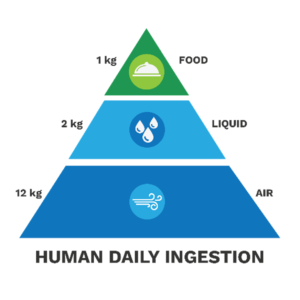
Is it possible that your home is making you sick? The reality is, absolutely. Our homes contain a plethora of items that can cause a multitude of symptoms. If you are experiencing symptoms primarily in your home, it could be Sick Building Syndrome, where consistent exposure to things such as mold and poor indoor air quality have created a revolving door of illness. Homes, both stick-built and manufactured, are comprised of building products containing volatile organic compounds (VOCs). VOCs are invisible gases emitted from solids and liquids found in the home. These gasses are constantly invading our breathing space and without adequate ventilation and containment, build up over time. If not addressed, buildup of these chemicals in indoor air is known to cause both short and long-term adverse health effects
Wondering which types of building products contain VOCs? Let’s look at a few examples:
- Laminate flooring
- Wall Coverings
- Paints, varnishes and stains
- Plumbing adhesives and sealants
- Adhesives, caulks, sealants and coatings
- Carpet
VOCs are not only found in your home’s structure, but are also emitted from everyday lifestyle sources, such as:
- Perfumes
- Laundry detergent
- Cleaners and disinfectants
- Air fresheners
- Cosmetics
Repeated or prolonged exposure to high levels of some VOCs can cause blurred vision, headaches, nausea, dizziness, coughing, burning eyes, respiratory irritation, skin rashes, respiratory illness, concentration difficulties, and other symptoms. Higher exposure can lead to liver damage, kidney and central nervous system irregularities, and some VOCs can even cause cancer.
The United States Green Building Council and the European Union suggest that levels greater than 500ng/L (.215ppm) of VOCs could pose a health hazard in homes (homeaircheck.com, n.d.). Not only can they cause the effects mentioned above, they can also exacerbate existing medical conditions, such as asthma and allergies. If you are experiencing symptoms seemingly only in your home, thankfully there are resources to help. Let’s explore three tools which can be used as a starting point in determining if your home could be the culprit:
First, if you are unaware whether you have an intolerance to chemicals, taking a survey called the QEESI , also known as the “TILT Test”, an assist (in conjunction with your doctor), to determine if you suffer from multiple chemical intolerances or MCI. The QEESI test is used to help understand you responses to different exposures. It is recommended that the test be taken twice if you were previously asymptomatic, then became symptomatic suddenly, after moving into a new home or other exposure event. This test is a tool and should not be used as a diagnosis. Sharing results with your doctor or a toxicologist can aid in determining if you suffer from a chemical intolerance.
Next, we will look at a tool to help evaluate your home and assess possible problem areas. Hayward Score is a simple online questionnaire that can help you identify key issues in your home which could be impacting your health. You will be provided with a detailed report to assist in the understanding of your indoor air quality, alongside ways to improve it. Hayward Score also provides resources to support remedying the issues discovered.
Lastly, if the likelihood is high that your home is, in fact, making you sick, Enthalpy Analytical – Mount Pleasant can help. We are a Michigan-based laboratory specializing in testing for VOCs, Mold, and Formaldehyde. Our VOC testing uses state-of-the-art technology, providing an entire fingerprint of the home, which allows us to predict primary sources of air contamination. VOC testing is available via two options: option one is a do-it-yourself kit where testing is performed by you at your convenience. Our Home Air Check kits are purchased through indoor air quality professional affiliates and shipped directly to you for sample collection. Kits are then returned to our laboratory for analysis. Once complete, your professional will send you a report and assist in interpretation. Option two is to hire an indoor air quality professional to come into your home and perform testing on your behalf. Professionals who utilize our lab services and can perform testing directly in your home are available by visiting the Indoor Air Quality Association website. We, in turn, will be able to assist your indoor air quality professional in providing recommendations on how to remove or reduce the VOCs in your home.
If you are suffering from symptoms in your home, you are not alone — thousands of people are affected by chemical sensitivities, VOC overload, mold and other indoor air quality issues every day. Utilizing the aforementioned tools can significantly help to lessen symptoms and improve your home’s indoor air quality to better achieve both home and body health.
Resources:
https://enthalpy.com/air/indoor-air/
https://www.lung.org/clean-air/at-home/indoor-air-pollutants/volatile-organic-compounds
https://www.homeaircheck.com/vocs/#1581437570523-e768af5a-dd74
https://www.homeaircheck.com/faq/#1572970428922-d064b67a-b54d
Want our latest blogs in your inbox?
Tell us a little about yourself.


